When this vine invades, watch out
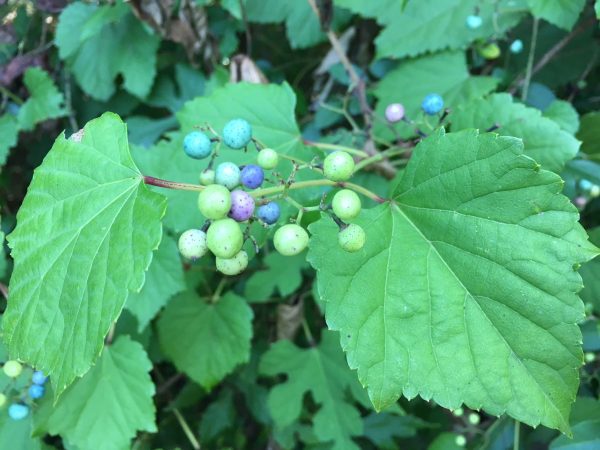
In August, “it becomes apparent that porcelain berry (Ampelopsis brevipedunculata) is making a bold attempt at taking over the world.” This witty observation from the Virginia Native Plant Society no longer strikes me as hyperbole. In all my years of conservation work in the Uwharries, I don’t believe I’ve ever encountered porcelain berry in anyone’s yard, let alone a natural area. I was blissfully unaware of this invasive vine until I turned my attention to my neighborhood park in Charlotte.
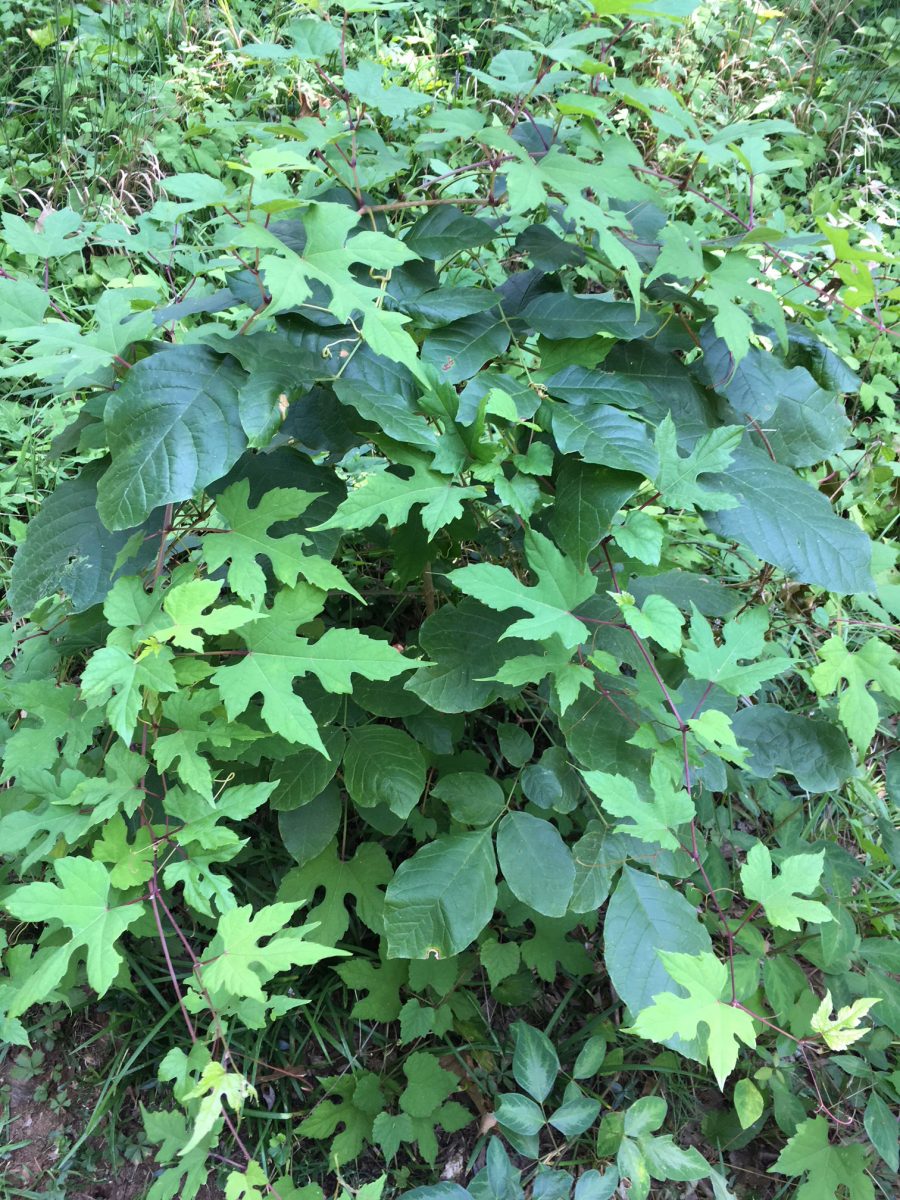
A hickory seedling in Latta Park, smothered by a porcelain berry vine. Photo: Ruth Ann Grissom
There, I first mistook it for a native grape, the muscadine (Vitis rotundifolia) or fox grape (Vitis labrusca). It seems I’m not the only one. NCpedia, the online version of The Encyclopedia of North Carolina, displays an image of porcelain berry with its fox grape entry. Instead, turn to “Mistaken Identity? Invasive Plants and their Native Look-Alikes,” available online courtesy of the New York Botanical Garden.
At first glance, they can be deceptively similar. Both have woody vines that attach with tendrils, but only grape bark peels in “narrow, papery strips.” The leaves are shiny with coarsely serrated edges, and their shape is somewhat round or softly lobed, but porcelain berry often sports at least a few deeply lobed leaves. Grapes have droopy, elongated clusters of flowers and fruits; on porcelain berry, they’re upright and round-topped or flat. Porcelain berries are generally smaller and less fleshy. They ripen in a kaleidoscope of colors, with shades of turquoise, lilac, violet, amethyst and midnight blue sometimes displayed simultaneously in the same cluster. The berries are speckled, reminding me of malted milk balls in an Easter basket.
Birds and mammals spread the berries far from the mother vine. Sources list them as growing quickly up to 25 feet, but from what I’ve observed, that’s a conservative estimate. The woody vine scrambles up trees, then the heavy foliage blankets the limbs.
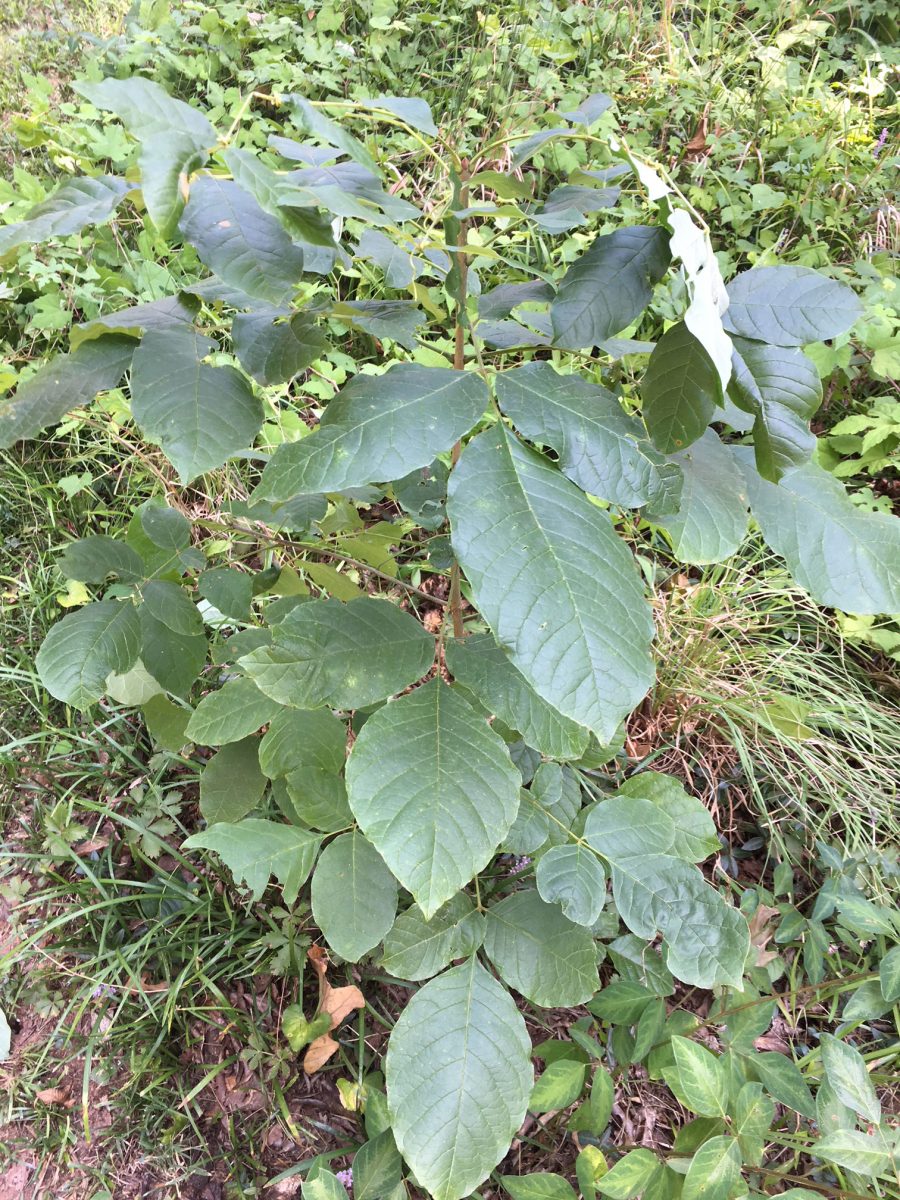 Hickory seedling, freed from the invasive vine. Photo: Ruth Ann Grissom
Hickory seedling, freed from the invasive vine. Photo: Ruth Ann Grissom
I first noticed it smothering a young burr oak in the park’s uplands. Only a few of the tree’s leathery leaves were visible. I had seen wisteria break the canopy of a poplar in the park, and I was determined this oak wouldn’t suffer a similar fate. One day, I returned with clippers and loppers. Dressed in long pants and tall socks, I picked my way through a patch of thigh-high weeds riddled with poison ivy.
The thick, woody vines look intimidating, but they offer only the slightest bit of resistance. It’s a satisfying sensation, like slicing a slightly under-ripe tomato with a straight-edged knife. Within days, the porcelain berry had wilted. This too was satisfying. I walked by every day just to watch it die. As it withered and browned, the oak’s shiny leaves re-emerged. The tree seems to have a newfound dignity and vigor.
Emboldened, I turned my attention to a lowly hackberry tree under the canopy of a glorious sycamore along the creek that runs through the park. Not an attractive tree to begin with, it seemed to cower under the porcelain berry. I then moved on to a Yoshino cherry that came to my attention last winter, after we had cleared the ligustrum from the slope above it. It appeared to be a weeper. For months, I had puzzled over its shape. Had someone planted a valuable tree in such an unlikely location? Had it seeded from a neighbor’s yard? No, it had bent under the burden of porcelain berry. To cut the vine at its source, I had to fight my way through the remaining stand of ligustrum on the opposite side of the creek. Farther downstream, I found a vine as thick as my wrist. I had to return with a handsaw.
Here, I must admit, cutting isn’t sufficient. The stumps need to be daubed with herbicide, but since I lack the license to apply them near a water source, they will need to be treated by professionals this fall. In the meantime, my intervention ought to disrupt much of the fruit set, giving us a chance to get ahead of new seedlings. Since the recent rains, I’ve taken to hand-pulling them in the uplands, focusing on areas where the vines are suppressing young trees. The forest’s mature canopy is in decline, and we’re seeing little in the way of natural regeneration. Failure to control this invasive vine is putting one of park’s best amenities, its tree canopy, at risk.
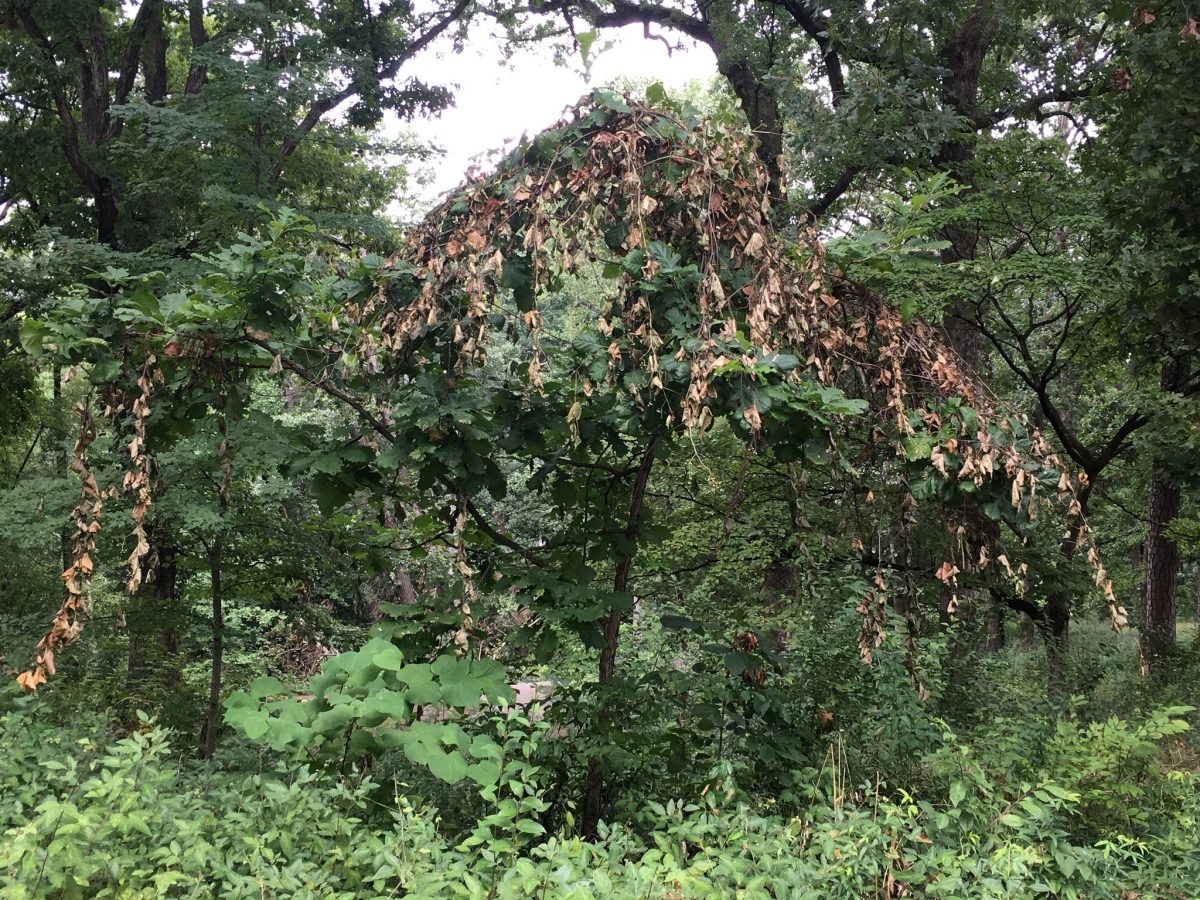 As the invasive vine dies, the young burr oak re-emerges in Latta Park. Photo: Ruth Ann Grissom
As the invasive vine dies, the young burr oak re-emerges in Latta Park. Photo: Ruth Ann Grissom
For now, porcelain berry is primarily an urban scourge. It was introduced into the nursery trade in the 1870s, when most folks in the Uwharries and other rural areas didn’t have access or money to procure the next new thing. Maybe people in the country also simply had the good sense not to plant it. Porcelain berry is still readily available online, largely without warnings of its invasive nature.
As development creeps and leapfrogs toward the Uwharries, porcelain berry is likely to follow, washed along waterways and carried by wildlife. Don’t be seduced by its beauty. Don’t be tempted to let it clamber over a fence or cover a difficult slope. Porcelain berry will not be contained. It will invade every corner of your yard, and it will escape into natural areas, putting it another step closer in its quest for global domination.
Many thanks to Lenny Lampel with Mecklenburg County Park and Recreation for helping me identify the burr oak.
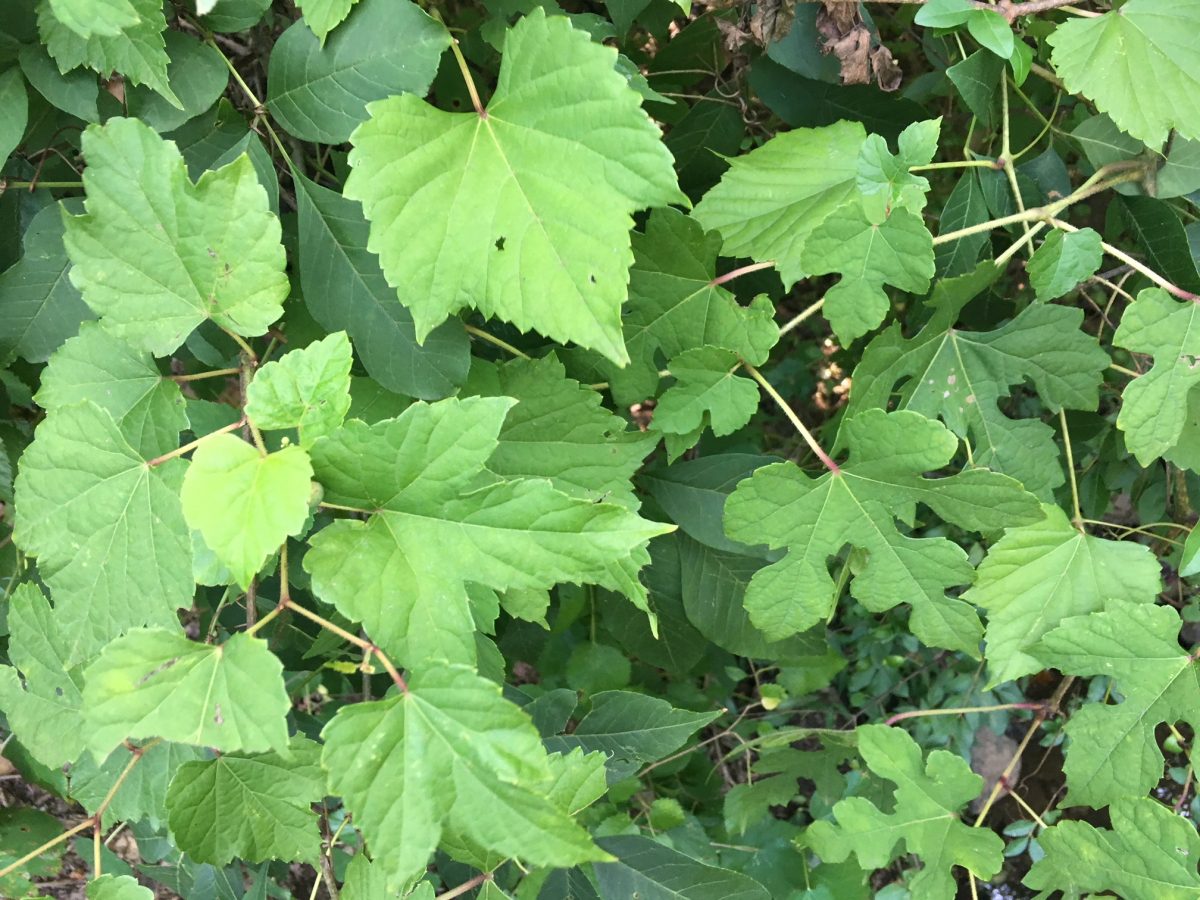 Unlike native wild grapes, porcelain berry leaves vary from somewhat rounded and mildly lobed to deeply lobed, as shown above. Photo: Ruth Ann Grissom
Unlike native wild grapes, porcelain berry leaves vary from somewhat rounded and mildly lobed to deeply lobed, as shown above. Photo: Ruth Ann Grissom